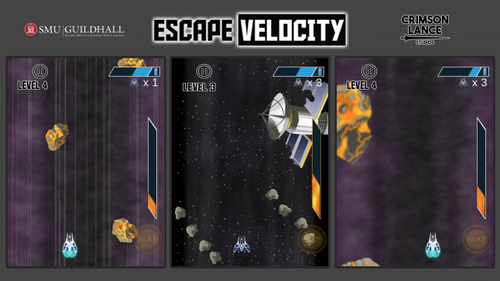Trending
Opinion: How will Project 2025 impact game developers?
The Heritage Foundation's manifesto for the possible next administration could do great harm to many, including large portions of the game development community.
SMU Guildhall production student, David Rosario III, reflects on what went well, what went wrong, and what lessons were learned from his first ever game project.





Escape Velocity banner. Art by Assistant Lead/Artist and Artist.
Escape Velocity is a vertical, endless scrolling mobile game made for Android tablets using the Unity engine. The player controls a spaceship trying to avoid obstacles in order to evade capture from an alien ship. The player wins the level by achieving Escape Velocity, the speed at which allows the player to warp to the next level. The player achieves Escape Velocity by filling an energy meter by collecting energy cores, depicted as floating canisters that appear on the screen as the player flies by.

Gameplay Screenshots: Escape Velocity. Art by Assistant Lead/Artist and Artist.
The project was created as a part of the curriculum at The Guildhall at Southern Methodist University (SMU Guildhall) in the first of three Team Game Projects. Development on Escape Velocity lasted from August-December 2016 for the student team, Crimson Lance Studios. I was a part of the project from the very beginning, serving as both an Assistant Team Lead and an Artist/Animator from pre-production onwards.
For myself and the majority of the team, this was the first game we had ever worked on. This project served as a valuable learning experience for all members of the team.
The greatest success of this project was our ability to remain true to the original vision of the project. Production began with a single concept, create a simple, arcade-style endless runner. The team was able to remain consistent with this vision through several iterations of gameplay and aesthetics.
For example, there were early milestones in which the team made changes to a setting based on an expert Kleenex Tester's critique. A particularly great moment was when we realized that this game was ultimately our vision and that we did not have to follow every single stakeholder suggestion. As long as the implementation fit our game pillars and worked for our general development milestones, then our original design was the right direction.
This served as a turning point for us as it allowed us to stop trying to add features that we didn’t believe in and put us on the right track for returning to our original vision.
As a team, we had communication issues from the very beginning. This led to each team member having different priorities within the project and began to create an unwanted culture within the team. People were unwilling to share ideas with one another out of fear of another person’s actions and team members were often afraid of confronting issues directly.
Combined with the team’s overall inexperience with game development, this made the development of Escape Velocity difficult at times and contributed to internal frustration and anger. At various points, our team displayed symptoms of all five of Patrick Lencioni’s dysfunctions of a team. This also had the unintended consequence of starting unfavorable rumors. While the rumors were not necessarily true, the obvious lack of friendship between team members began to reflect negatively on our reputation.
This led to decisions that did not have universal buy-in from the team with no one being aware of the discontent. Late night builds became a regular practice which further hurt the project and added lack of sleep to existing issues. Unhappiness and inefficient work practices became commonplace as we all struggled to find our way in our first project.
Probably the most important lesson we learned from this project was how to persevere. Our team managed to fight and claw and iterate itself until we became the best versions of ourselves that could have existed at that time. The project was ultimately completed and it was done with more than we had originally planned to include within the game. It was difficult, but we managed to finish and we successfully met our release date.
For a group of students trying to learn about game development, this experience served as an incredible learning opportunity. In regards to team dynamics and professionalism, we could not have asked for a more chilling dose of reality. Not every team gets along and working in a team is hard if you’ve never done it before. There’s a difference between working in teams on small undergraduate projects and working on a team to create something as creatively and technically demanding as a video game. There must be team-wide buy-in and complete participation from everyone involved. Culture and communication is of the utmost importance on all levels of a team and when it is lacking, everyone feels the effects.
This experience also proved to us that learning how to be a proper professional is a skill and it is one that must be learned early in the industry. Game development is an exhausting process that can hit extreme emotional highs and lows. Mood and morale is contagious and you must be able to remain a consummate professional, especially in a leadership position as your team looks to you for guidance. It is unacceptable to allow emotions to color your professionalism in times of strife. Team members are people and it is okay to show emotion, but carefully managing oneself is a part of being an effective team member.
For a first attempt at creating a game, it was made clear that all of us had some growing to do. I believe that developing this project served as a valuable learning tool that we will never forget. Moving forward, we are more focused on being professional and honest with our future team members to avoid the communication issues we encountered during this project.

Team Photo: (From left) Programmer, Level Designer, Game Designer, Assistant Lead/Artist, Artist
Read more about:
BlogsYou May Also Like